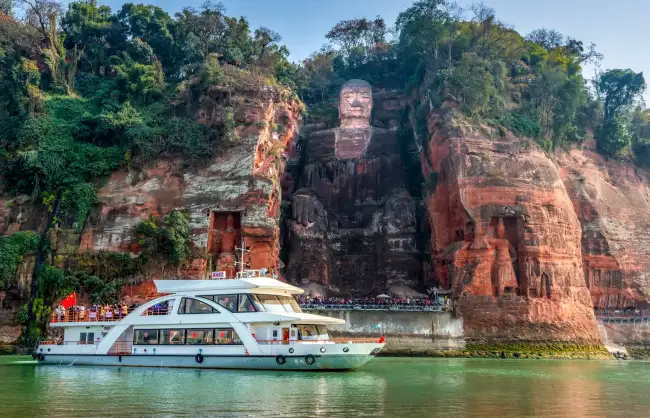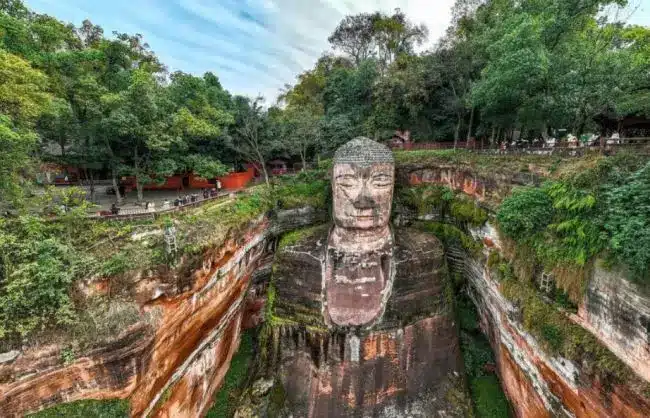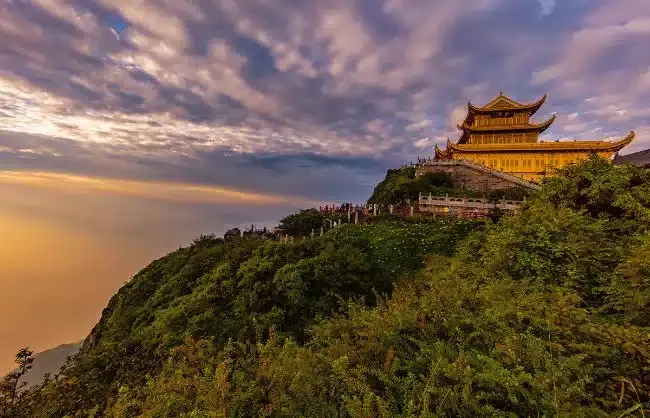Written by Clementine |
Leshan Giant Buddha, also known as Lingyun Giant Buddha, is located in Leshan City, Sichuan Province, and situated at the confluence of Dadu River, Qingyi River and Minjiang River. This statue of Maitreya is the largest stone statue carved on cliff in China, and the largest seated Buddha statue in the world. How tall is Leshan Giant Buddha? The full height is 71 meters.
Leshan Giant Buddha is a masterpiece of cliff carving art in the Tang Dynasty, as well as an architectural wonder of China. It has always been a Buddhist holy land and a must-visit tourist attraction during Chengdu tours. In 1996, Mt. Emei and Leshan Giant Buddha was listed into the World Cultural and Natural Heritage List, and became the only World Cultural and Natural Heritage site in western China.

Essential Travel Information
- Chinese Name:乐山大佛
- Address: 2435, Lingyun Road, Shizhong District, Leshan City, Sichuan Province
- Opening Hours:07:30-18:30, 19:30-22:30 (April 1st – October 7th); 08:00-17:30, 19:00-22:00 (October 8th to March 31st of the following year)
- Entrance Ticket:RMB80 per adult (including Leshan Giant Buddha, Wuyou Temple and Mahao Cliff Tombs); Boat Cruise Ticket: RMB70; Night Cruise Ticket for Three Rivers: RMB 228 in wet season; RMB138 in dry season
- Time Needed: about 2-4 hours
Leshan Giant Buddha Fun Facts & History
When, Why and By Whom Was Leshan Giant Buddha Built?
The construction of Leshan Giant Buddha began in the first year of Kaiyuan in the Tang Dynasty (713 AD) and was completed in the 19th year of Zhenyuan (803 AD), spanning about 90 years. It was built by three generations and going through four emperors.
Leshan Giant Buddha in Sichuan is a seated Maitreya Buddha. The people in the Tang Dynasty worshiped Maitreya Buddha, and the Buddhist scriptures imply that “once Maitreya is born, the world will be peaceful”. Empress Wu Zetian ordered people to write a Buddhist book to prove that she was the reincarnation of Maitreya, which helped her to come into power. Because Wu Zetian strongly advocated Maitreya, it was popular for people to build Maitreya at that time. What’s more, Maitreya is also considered as a Buddha that can bring happiness and bright future.
The Minjiang River, Qingyi River and Dadu River converged at the foot of Lingyun Mountain in the Leshan area. It is said that in Tang Dynasty the water was fierce and ships often capsized, threatening the lives of the people. In order to suppress the water, Monk Haitong was determined to gather human and material resources to carve out a giant Buddha here. And when Monk Haitong built the giant Buddha, he also chose to build a Maitreya.
What Does the Leshan Giant Buddha Represent?
Leshan Giant Buddha is not only the highest ancient stone-carving Maitreya Buddha in the world (71 meters high), but also the pinnacle of Chinese ancient engineering wisdom, Buddhist culture and natural landscape. With the majestic momentum of “the mountain is a Buddha, the Buddha is a mountain”, it has become an eternal monument in Chinese civilization for natural reverence, the inheritance of carving techniques, and spiritual beliefs.
Leshan Giant Buddha Closed Its Eyes and Shed Tears?
Leshan Giant Buddha in Sichuan has experienced four “eyes closed” and “tears shed”, respectively in 1962, 1963, 1976 and 2000. It is regarded by the common people as a magical and mysterious phenomenon of gods implying disasters. But the scientific explanation is that the real reason for the Buddha statue closing its eyes is due to acid rain or acid deposition caused by air pollution. Acid rain can corrode buildings, causing holes and cracks in them.
Popular Tours:
- One Day Chengdu Tour for Panda Base and Leshan Giant Buddha
- 4 Days Chengdu & Chongqing Highlights Tour

What to See in Leshan Giant Buddha Scenic Area
Architectural Highlights
Leshan Giant Buddha, as the same height as the mountain, is a sitting Buddha stepping into the river with both hands touching on knees which looks solemn.
Detailed Data: The head is 14.7-meter-high and 10-meter-wide, with a total of 1,051 coiled hair buns on it. These buns look like a part of the whole head, but they are actually embedded on it one by one. The ears is 7-meter-long, and the nose and eyebrows are 5.6-meter-long. The mouth and eyes are 3.3-meter-long, the neck is 3-meter-long, the shoulders are 24-meter-wide (as long as a basketball playground), and the fingers are 8.3-meter-long. In addition, the instep is 8.5-meters-wide, where more than 100 people can sit on at the same time.
Leshan Giant Buddha has an ingenious and invisible drainage system, which plays an important role in the protection of the giant Buddha. There are gutters on the 4th, 9th and 18th storey of buns respectively. And there are also some hidden gutters and channels distributing on the head, chest, arms, backs and in the clothes. These gutters are part of the scientific drainage, moisture insulation and ventilation system, preventing the erosion of the Buddha.
Lingyun Plank Road and Nine-Turn Plank Road
Along the Lingyun Plank Road at the left edge of the Buddha, visitors can directly reach the bottom of the Buddha. Looking up at the giant Buddha here, you will feel the magnificence and sacredness of Buddha. There is a serpentine and steep ancient plank road on the right side of the Buddha, called Nine-Turn Plank Road. It was built simultaneously with the Buddha statue. Walking along this plank road, you can reach the top of Lingyun Mountain and see the exquisite sculpture on the head of the Buddha.
Lingyun Temple
Lingyun Temple is a triple courtyard building, consisting of the Heavenly King Hall, the Main Hall, and the Sutra Library. Surrounded by lush trees and thriving incense, the temple is a great place to experience Buddhist culture. Tourists can pray for peace and health here.
Giant Sleeping Buddha
On the surface of Qingyi River, several mountain peaks are connected together. Upon closer inspection, you will find that its shape resembles a lying Buddha statue, with the Buddha’s head, body, and feet all present. This sleeping Buddha has a length of over 4000 meters, facing upwards with a kind and solemn expression.
Vegetarian restaurant
Vegetarian restaurant here is also famous. The “meat dish” that you eat in vegetarian restaurant is made by bean product, which tastes like meat but is not real meat. No matter the taste or form, you can find the feeling of returning to nature and enjoy a beautiful vegetarian meal here.
How to Visit: By Boat or Hiking
There are two classic routes to visit Leshan Giant Buddha Scenic Area:
Mountain Hiking
Route: North Gate – Lingyun Temple – Monk Haitong Cave – Top of the Giant Buddha – Nine-Turn Plank Road – Buddha Foot – Oriental Buddha Park – South Gate
Along the Nine-Turn Plank Road, you can observe the details of the giant Buddha up close from different heights and angles, and feel its majesty and solemnness .
Cruise Sightseeing
Tourists who still feel inadequate observing the Buddha up close or lack physical strength can choose to cruise the river to admire the Buddha from afar, take a panoramic view of the Giant Buddha and Sleeping Buddha, and shoot precious photos during Chengdu travel.
.jpg)
Best Time to Go
The best time to visit Sichuan Leshan Giant Buddha is in Spring and Autumn, especially April and Mid to late October. During these months, the weather is more pleasant. The scenery is particularly beautiful after sunrise and before sunset. Besides, during November to March, there are fewer tourists and the Zen-like atmosphere is even more pronounced after the snow. During the rainy season from June to August, the mountains are shrouded in clouds and mist, and the Buddha statue is faintly visible.
Note: You’d better avoid the official holidays in China, especially National Day and Chinese New Year, because these periods are peak travel season with tourist attractions being very overcrowded.
How to Get to Leshan Giant Buddha
From Chengdu
- Take high-speed train from Chengdudong Railway Station orChengdunan Railway Station to reach Leshan, which takes about 1 hour.
- Driving from downtown Chengdu to Leshan Giant Buddha via Beijing–KunmingExpressway and Chengdu-Leshan Expressway takes around 2 hours to cover a distance of about 150 kilometers.
- Take a long-distance bus from Chengdu Xinnanmen, East, ChadianziBus Station to Leshan city, which takes about RMB50.
From Mt. Emei
- It only takes about 20 minutes to reach Leshan by high-speed train from Mt. Emei.
- The whole journey from Mt. Emei to Leshan Giant Buddha is about 50 kilometers and takes about 50 minutes’ driving.
Starting from Leshan High-speed Railway Station, transfer to Bus No.1, No.3, No.12, No.22 and No.601, and get off at Leshan Giant Buddha Station.

By Ship
Located at the confluence of Minjiang River and Dadu River, there are many ferries to Leshan Giant Buddha. And there are also some ferries that can get to Yibin, Luzhou or Chongqing at the Leshan Port.
Useful Travel Tips
- Mountain hiking requires a 2-3 hour walk, and it is recommended to wear comfortable non-slip sneakers.
- Prepare sunscreen, hat, and foldable umbrella or lightweight raincoat in summer.
- The steps of PlankRoad are narrow (0.6-1.45 meters wide), and it is necessary to use handrails to walk slowly. Those who are afraid of heights should enter with caution.
- Leshan is less than 200 kilometers away from Chengdu, so a day trip to Leshan from Chengdu is easy.
- Leshan Giant Buddha and Mt. Emei are relatively close and can be visited together.
Recommended Chengdu Tours including Leshan Giant Buddha:







